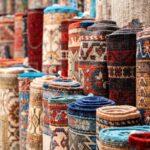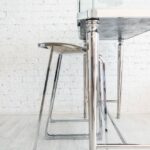Have you ever dreamed of a staircase that seems to defy gravity, blending seamlessly into your home while adding a touch of modern elegance? Floating staircases are the epitome of contemporary design, offering a sleek and minimalist aesthetic that transforms any space into a work of art. These architectural marvels are not only visually stunning but also functional, making them a popular choice for homeowners and designers alike.
In this comprehensive guide, we’ll explore everything you need to know about floating staircases—from their design and materials to installation, benefits, and maintenance. Whether you’re planning a home renovation or simply curious about this innovative staircase style, this article will provide all the insights you need. For more architectural inspiration, check out
What is a Floating Staircase?
A floating staircase is a modern staircase design where the steps appear to “float” without visible support. Unlike traditional staircases, which rely on bulky stringers or risers for structural integrity, floating staircases use hidden supports, such as wall anchors or cantilevered designs, to create the illusion of weightlessness.
Types of Floating Staircases
Floating staircases come in various styles to suit different architectural needs and preferences. Here are the most common types:
- Straight Floating Staircase: A simple, linear design that works well in minimalist spaces.
- Spiral Floating Staircase: A space-saving option with a dramatic, sculptural appearance.
- Curved Floating Staircase: Adds elegance and fluidity to any room with its sweeping curves.
- Cantilever Staircase: Features steps anchored directly into the wall, creating a true floating effect.
- L-shaped Floating Staircase: Combines functionality and style with a 90-degree turn.
Design Ideas and Inspirations
Floating staircases are incredibly versatile and can be customized to fit various interior styles. Here are some design ideas to inspire your next project:
Modern and Minimalist Designs
Floating staircases are a staple in modern and minimalist homes. Pairing sleek wooden treads with glass railings creates a clean, open look that enhances natural light flow.
Industrial Aesthetic
For an industrial vibe, consider using metal treads and exposed steel supports. This design pairs well with raw materials like concrete and brick.
Rustic Charm
Combine floating stairs with reclaimed wood and wrought iron railings for a rustic yet contemporary feel. This design works beautifully in farmhouse-style homes.
Creative Enhancements
- Lighting: Add LED strips under each step for a dramatic floating effect at night.
- Glass Panels: Use transparent glass railings to maintain an unobstructed view.
- Mixed Materials: Combine wood, metal, and glass for a unique, multi-textured look.
Materials Used in Floating Staircases
The choice of materials plays a crucial role in the aesthetics, durability, and functionality of a floating staircase. Here’s a breakdown of the most popular options:
Wood
- Types: Oak, walnut, maple, and bamboo are common choices.
- Advantages: Warm, timeless, and versatile.
- Styles: Can be stained, painted, or left natural to match your décor.
Glass
- Safety: Tempered or laminated glass ensures durability and safety.
- Aesthetics: Creates a transparent, airy look that enhances the floating effect.
- Maintenance: Requires regular cleaning to maintain clarity.
Metal
- Options: Steel, aluminum, and wrought iron.
- Benefits: Strong, durable, and ideal for industrial designs.
- Customization: Can be powder-coated in various colors.
Concrete
- Durability: Extremely strong and long-lasting.
- Style: Perfect for modern and industrial interiors.
- Drawback: Heavier and requires professional installation.
Structural Design and Engineering
Floating staircases rely on precise engineering to achieve their signature look. Here’s how they’re supported:
Hidden Fixings
Steps are anchored into the wall using concealed brackets or cantilevered designs, creating the illusion of floating.
Glass Supports
In some designs, tempered glass panels act as both railings and structural supports, enhancing the staircase’s transparency.
Safety Considerations
- Adhere to local building codes to ensure safety.
- Install railings or balustrades for added security.
- Use non-slip materials or coatings on the treads.
Professional Installation
Due to the complexity of floating staircases, professional installation is highly recommended. Custom engineering ensures the staircase is both safe and visually stunning.
Benefits of Installing a Floating Staircase
Floating staircases offer more than just aesthetic appeal. Here are some of their key benefits:
Space-Saving Design
Floating staircases take up less visual and physical space, making them ideal for smaller homes or open-concept layouts.
Enhanced Natural Light
The open design allows light to flow freely, brightening up your space and creating an airy atmosphere.
Modern Aesthetic
With their sleek lines and minimalist design, floating staircases add a contemporary touch that increases your home’s value.
Customization
From materials to finishes, floating staircases can be tailored to suit your personal style and architectural needs.
Installation Process and Cost Considerations
Installing a floating staircase involves several steps and factors that influence the overall cost:
Step-by-Step Installation
- Design and Planning: Work with a professional to create a custom design.
- Structural Assessment: Ensure your walls and floors can support the staircase.
- Fabrication: Materials are cut and prepared according to the design.
- Installation: Steps are anchored, and railings are added.
Cost Factors
- Materials: Wood and glass are typically more expensive than metal.
- Complexity: Curved or spiral designs cost more due to their intricate engineering.
- Labor: Professional installation adds to the overall cost.
DIY vs. Professional Installation
While DIY kits are available, they may not provide the same level of safety and customization as a professionally installed staircase.
Maintenance and Care Tips for Floating Staircases
Proper maintenance ensures your floating staircase remains safe and beautiful for years to come. Here are some tips:
Routine Cleaning
- Use a soft cloth and mild cleaner for wood and glass.
- Avoid abrasive materials that can scratch surfaces.
Structural Integrity
- Regularly inspect the staircase for loose treads or railings.
- Tighten screws and brackets as needed.
Repairs
- Address minor issues promptly to prevent further damage.
- Consult a professional for major repairs or replacements.
Common Questions About Floating Staircases
Are Floating Staircases Safe?
Yes, when installed correctly, floating staircases are safe. Adhering to building codes and using high-quality materials ensures stability.
Can Floating Stairs Be Installed in Small Spaces?
Absolutely! Straight or spiral floating staircases are excellent space-saving options.
How Long Does Installation Take?
The timeline varies depending on the design and materials but typically ranges from 2 to 4 weeks.
What Are Alternatives to Floating Staircases?
Alternatives include traditional staircases, spiral staircases, and modular designs.
Conclusion
A floating staircase is more than just a functional element—it’s a statement piece that elevates the style and sophistication of any home. With their modern design, space-saving benefits, and customizable options, floating staircases are an excellent choice for homeowners looking to make a bold architectural statement.
Ready to transform your space? Explore floating staircase designs, consult with professionals, and bring your vision to life. Whether you’re building a new home or renovating an existing one, a floating staircase is sure to leave a lasting impression.
Key Takeaways:
- Floating staircases combine modern aesthetics with functionality.
- They come in various styles, including straight, spiral, and cantilevered designs.
- Materials like wood, glass, and metal offer endless customization options.
- Professional installation ensures safety and structural integrity.
- Regular maintenance keeps your staircase looking and performing its best.



